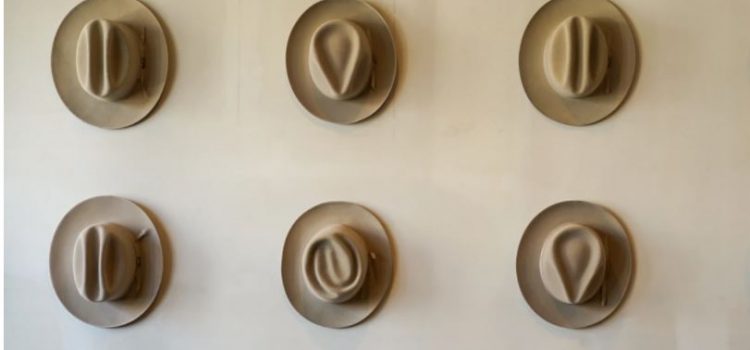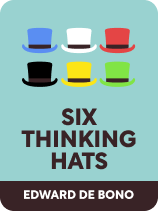

This article is an excerpt from the Shortform book guide to "Six Thinking Hats" by Edward de Bono. Shortform has the world's best summaries and analyses of books you should be reading.
Like this article? Sign up for a free trial here .
What are the six thinking hats? What mode of thinking does each color represent?
Six Thinking Hats is Edward de Bono’s book about how to think more efficiently. In his book, he suggests trying out different methods of thinking—trying on different colored hats—in order to come up with better thought-out solutions to problems.
Keep reading to learn about de Bono’s six hat theory.
Six Thinking Hats
Six Thinking Hats is a handbook for training people to think more efficiently and productively, using the metaphor of wearing different hats for different types of thinking. Since the book’s original publication, many institutions have implemented it with great success, particularly in business and educational contexts. Author Edward de Bono is a Maltese doctor and psychologist. He’s credited with coining the term “lateral thinking,” and he’s also known for advocating more teaching of thinking skills in schools.
Six Thinking Hats was originally published in 1985. This guide refers to the revised and updated version published in 2017.
The Six Modes of Thinking
De Bono’s six hats represent the following types of thinking:
- The blue hat is for metacognition, or the overall organization of the thinking process.
- The white hat is for gathering neutral information.
- The red hat is for emotions.
- The black hat is for criticism.
- The yellow hat is for positive feedback and developing solutions.
- The green hat is for new, creative ideas.
When you face an important decision, the hats can help you compartmentalize and organize your thinking. In group discussions, the hats help to keep things clear and orderly, as well as making sure that no important ideas are neglected.
The six thinking hats allow you to pull apart the tangle of normal thinking and sort it into six self-contained strands. Because you keep the strands separate right from the beginning, you can weave them together in a more deliberate and systematic way. This improves the efficiency of the thinking process.
Thinking as Exploration
Our traditional view of advanced thinking is debate: the refinement of ideas through argument and confrontation. The Six Hats method asks you to see thinking as mental exploration in a particular direction. In the physical world, you can always check a compass and then deliberately choose to walk to the north, south, east, or west. Think of the six hats as mental compass points. At any point, you can stop and consciously decide on the best course.
Trying to walk north and south at the same time would be pointless and exhausting for your physical body. Similarly, your brain works best when it can focus on one type of thinking at a time. If it’s looking for danger, let it look for danger uninterrupted. If it’s creatively breaking existing patterns to make new ones, let it do that.
Conducting a systematic mental exploration of the problem allows you to draw a detailed map of the context for any decision you need to make. With this detailed map in hand, your decisions will be so thoroughly considered that the best route will become obvious.
Why Hats?
- There’s a pre-existing association between thinking and hats via the phrase “put your thinking cap on.”
- A hat is easy to put on and take off. This mirrors the six different thinking styles, which you can call upon in a flexible and relatively effortless manner.
- Hats are visually obvious. This signposting function is important in the Six Hats method because you want your current thinking direction to be clear to everyone, including to yourself. By putting on your metaphorical hat, you’re signposting the direction that your thoughts will take.
- Wearing a hat is temporary. You put hats on and then take them off, and who you are doesn’t change fundamentally in the process. In the Six Hats system, there are no thinking specialists, no “yellow hat people” or “black hat people.” (The only exception is the blue hat role, which is usually executed by one person at a time—more on this in Chapter 2.)
- The focus on clothing rather than the individual builds cognitive flexibility. Consider an actor who always dresses up in the same costume and plays the same role. Now consider an actor who can don wildly different costumes and excel in a variety of roles. Who do you admire more?
The Blue Hat
The blue hat is the master hat. Blue hat thinking is metacognition, or thinking about thinking. The master hat is the same color as the sky, to symbolize the bird’s-eye view you’re taking of the process when you’re wearing this hat. The blue hat determines what exactly you’re trying to achieve and how you’ll go about doing it. It also monitors the discussion to make sure everything stays on track.
For simplicity, usually the chair of the meeting wears the blue hat for the whole meeting—however participants can also don their blue hats to offer procedural suggestions.
Blue hat data includes planning documents such as agendas, checklists, calendars, and Gantt (project tracking) charts. It also includes final outputs such as reports and overviews. Blue hat contributions include procedural suggestions, comments on the progress of the discussion, and suggestions for next steps.
In the blue hat role, asking questions is a powerful way to focus attention. Questions often result in more open-ended, independent thinking than directives. For best results, mix specific, targeted questions with more general, open questions.
How to Use the Blue Hat
- You can put on your blue hat at any point. If you feel that the procedure could be improved, or you’d like to suggest a change of hat, put on your blue hat and ask for this.
- Blue hat thinking fits most naturally at the start and end of a discussion, though you may need to cycle back to it if the discussion strays off track. The first blue hat period is concerned with framing the topic clearly, setting goals for the session, and planning the sequence of hats to be used. The final blue hat period is concerned with creating an overview of the discussion that just took place, finalizing any decisions that remain outstanding, and determining what further action needs to be taken and by whom.
- Blue hat thinking is a specific skill, and sometimes people who are excellent at leading other types of meetings are not naturals at wielding the blue hat. If you usually lead meetings but are not very confident or skilled with the blue hat, consider allocating the role to someone else.
The White Hat
The white hat is the neutral hat. White hat thinking is the gathering of relevant factual information. The white hat considers what you know about the situation, how reliable this information is, what you don’t yet know, and how you’ll find the missing information. Avoid interpreting data while wearing this hat. Words like “because” and “so” belong to the yellow and black hats.
When you wear the white hat, you think about objective data. Emotions, judgments, and interpretations are quiet. Think of a white sheet of paper ready to be filled with information. This is the white hat.
White hat data usually takes the form of facts and figures: sales figures, financial information, objective facts. These should be as specific as possible, and ideally should include a date (for example, polling data used for a political campaign should be clearly labeled with the date).
White hat data also includes the reported opinions and feelings of people not at the meeting, if they’re relevant.
How to Use the White Hat
- Distinguish and mark the accuracy of facts. It’s fine to contribute facts that you aren’t completely sure of. But make sure that these are annotated with the contributor’s level of certainty, and confirm any wishy-washy facts before using them to make decisions.
- It’s good practice to put on the white hat toward the start of the session. You may also want to put the white hat on periodically to check for information around any new ideas or proposals that arise.
- Make sure that you explore the whole field of relevant data while wearing this hat. It’s easy to fall into the trap of only contributing information that supports your point of view. But this defeats the purpose of the white hat, which is to map out the cognitive terrain in an objective way.
- Facilitators: Guide the granularity of the data you’re targeting through questions. For example, you could say, “Let’s white-hat the economic environment for our product. What do we know?” Then you could narrow this to “Now find me X competitor’s annual report for last year.”
The Red Hat
The red hat is the emotional hat. Red hat thinking is pure emotion. Red is the color of blood, symbolizing strong emotions like passion and anger. Under the red hat, you reflect on exactly how you feel about a person or situation.
The red hat is the opposite of the white hat. The white hat wants pure facts, stripped of emotion and agenda. The red hat wants your emotions, intuitions, and gut feelings about the issue, with no need for supporting evidence or explanations.
Examples of red hat contributions are:
- “This seems like a terrific investment to me. I’m feeling really keen.”
- “I don’t know what it is exactly, but something about this deal smells fishy.”
Red hat data includes emotions, intuitions, and gut feelings. Emotions are necessary for proper thinking, and they play an important role in any decision. In fact, any final decision needs to feel good as well as being intellectually justifiable. Suppressing emotions just makes them pop up again cloaked in rationality. The red hat allows people to express their emotions fully and honestly, without needing any justification or rationalization. Intuitions are quick assessments of a situation that you can make based on significant previous experience. Gut feelings are premonitions you have about the outcome of a situation (for example, “You know, I just can’t see this ending well for anybody.”)
How to Use the Red Hat
- Emotions change fast. It’s possible to refine and modulate even very deep-seated emotions through discussion and over time. Because of this, it’s good practice to return to the red hat several times during a discussion. For example, you might want to do some red hatting at the start to check people’s initial reactions, and some more in relation to potential solutions.
- If there are very strong emotions on a particular issue, consider invoking the red hat early in the discussion to clear the air.
- Under this hat, seek to get to the core of the emotion quickly. Actively discourage explanations and justifications. You can do this by allocating only a very short amount of time, say 30 seconds, per person.
The Black Hat
The black hat is the critiquing hat. Black hat thinking looks for problems and logical flaws. The black hat is focused on survival—it’s the hat that looks out for danger and keeps us alive. Black hat thinking kept our ancestors from being eaten by predators or falling off cliffs. Being sensitized to danger is a crucial part of our neurochemistry and serves a valuable purpose. The black hat considers the questions: “What’s wrong with this picture?”, “What’s the worst possible outcome?”, and “What are the risks?” Specifically, the black hat asks: “Has this type of thing failed before? If so, why?”
Current education systems, especially at post-secondary level, teach and reward critical thinking, so it’s no surprise that many people are experts with the black hat. They excel at finding problems everywhere and pointing out logical flaws. This is useful and important, because black hat thinking keeps us from making irreparable mistakes. But too much of the black hat can stunt our thinking under other hats, especially yellow and green.
The black hat gets misused in two main ways.
- People who are black hat thinkers by default often have great difficulty switching off the criticism when it’s time to work with the other hats. This can mean that new ideas get squashed before they have time to grow, or that a proposal is thrown out entirely rather than examined for its potential strengths.
- Black hat thinking can easily become tied to ego. Using the black hat to feel smarter than others is a common abuse of the black hat. Before making a black hat contribution, stop and ask yourself: “Is this genuinely helpful, or am I just saying it to make myself look good?”
How to Use the Black Hat
- Be as critical as you like. When it’s designated black hat time, rip as many holes in the idea as you can. By criticizing the project now, you’re providing a valuable service: You’re making sure that something flawed doesn’t go out into the world and do damage or lose the company a lot of money. But:
- Practice switching off the criticism immediately when you take off the black hat.
- Remember that black hat contributions are made alongside other contributions—they don’t override them.
- Be vigilant about not letting black hat thinking creep into sections designated for other hats. You may need to call people out directly on this: “Stan, that’s an important thought, but it’s more of a black hat contribution. We’ll get to the black hat in a minute. For now, what neutral information can you give me on this matter?”
- Don’t police people for being “too negative.” Give expert black hat thinkers free rein to do their thing and rip the arguments and proposals on the table to shreds…but only when it’s time for the black hat.
The Yellow Hat
The yellow hat is the constructive hat. Yellow hat thinking is positive and concrete. You can remember this easily: Builders often wear yellow hardhats when working on new buildings, and yellow is the color of sunny optimism. Under the yellow hat, you find ways to be optimistic. You search for value. You ask: “What’s the silver lining?” and “How can I make this work?”
Like black hat data, yellow hat data is based on logic. Under both the black and the yellow hats, you’re considering ideas in light of your and other people’s past experiences. But this time, instead of thinking about everything that’s gone wrong in the past, you’re thinking about what’s worked.
Yellow hat contributions are about improvement. Proposals are classic yellow hat contributions. The yellow hat is concerned with generating proposals, finding sound reasons why proposals are likely to work, and developing strong proposals further.
Simple, obvious suggestions are just as valuable as revolutionary ones. In fact, you may choose to save this type of serious out-of-the-box thinking for the green hat.
How to Use the Yellow Hat
- Because most people have never been trained in yellow hat thinking, it might take a little while to get the hang of it. It may help to think of it as the opposite of black hat thinking: Wherever you see strong points, highlight them. Wherever you see weaknesses, try to build them up instead of tearing them down.
- Consider using the yellow hat directly after the black hat to deliberately strengthen the weaknesses that have been identified by the black hat.
- Yellow hat contributions can be tricky to monitor, as the borders with the red hat (positive emotions) and the green hat (new ideas) can be fuzzy. Don’t be too rigid about policing this line—if a contribution seems to belong elsewhere, just raise the issue of whether it might be better to address later on under another hat.
- It can also be difficult to put your finger on the difference between yellow hat, black hat, and white hat contributions, because written down they can all look very similar. The difference between these three hats is context. Let’s say you’re looking to construct a building in a particular neighborhood. Under the white hat, someone has provided the following information: “Planning regulations in this neighborhood stipulate that all new buildings be below eight stories.” If your goal is to build a skyscraper, this piece of information fits under the black hat: It’s a flaw in the design of your project, and means the project will have to be either reworked or relocated. But if your goal is to build an eight-story building with a gorgeous view from the top, the planning regulation fits under the yellow hat: It’s a sound reason why the project is more likely to succeed.
The Green Hat
The green hat is the creative hat. Green is the color of new growth, and green hat thinking looks for new and original ideas. Though the attitudes that drive green hat and yellow hat thinking are quite similar (a sense of possibility; a desire to build rather than break down), the thinking styles involved are qualitatively different. For example, you might know someone who is very optimistic but quite conventional in their ideas. You might also know someone who is highly creative but not very optimistic. This is why we consider the green hat and the yellow hat separately in practice.
The green hat asks, “How can I look at this problem differently?” and “Where does this new idea take me? When you put on the green hat, you’re coming up with combinations of ideas that, as far as you know, nobody has ever considered before.
Po and the Stone That Jolts the Wheel out of the Rut
Green hat thinking is about jolting yourself out of your normal thinking patterns. Think of a horse-drawn carriage being driven along a dirt track. Though the whole path is available to the carriage, it quickly settles into the ruts left by previous carriages. The wheels will stay in the ruts until they’re jolted out, either through an input of deliberate energy from the driver and horses or by an obstacle such as a stone.
Similarly, thinking will tend to follow normal, well-traveled pathways unless something gets put in the road. A provocation is a mental stone in the rut of normal thinking. A provocation might be something like “People should be paid to have pets” or “A manager’s subordinates should decide whether or not she gets promoted.”
Po, standing for “provocative operation,” is a word you can use to signpost a provocation. The deal is that you’re not allowed to meet a po with a black hat—you have to run with the suggestion. Here are some examples of po:
- Po roads should have a special motorbike lane.
- Po we should get rid of the whole HR department.
How to Use the Green Hat
- While it’s usually not too hard to generate pieces of information and positive and negative analyses, completely new and creative ideas are different beasts. Sometimes, as hard as you try, you simply won’t be able to generate any interesting new ideas. Under the green hat, what matters isn’t the output volume but the time and effort that you’ve put in.
- Dedicate adequate time to the green hat. In contrast to the red hat, in which extra time just tends to muddy the waters, under the green hat time can be the difference between no ideas and excellent ideas.
- Keep the black hat far away. The black hat is poison for undeveloped idea seedlings.
- Don’t gatekeep wacky ideas, even if they seem completely useless. Note them down, and see where they take you.
- Make sure to allocate time to the green hat, even if there’s no pressing problem to solve or pressure to develop a new idea. You never know what might arise.
- Train yourself and others to recognize good ideas when you see them. In many groups that have trouble being creative, the problem isn’t actually a failure to generate good ideas—it’s a failure to recognize and develop good ideas when someone suggests them.

———End of Preview———
Like what you just read? Read the rest of the world's best book summary and analysis of Edward de Bono's "Six Thinking Hats" at Shortform .
Here's what you'll find in our full Six Thinking Hats summary :
- A handbook for training people to think more efficiently and productively
- An explanation of each of the six thinking hats created by Edward de Bono
- How to calm your inner critic and dramatically cut your decision-making time






